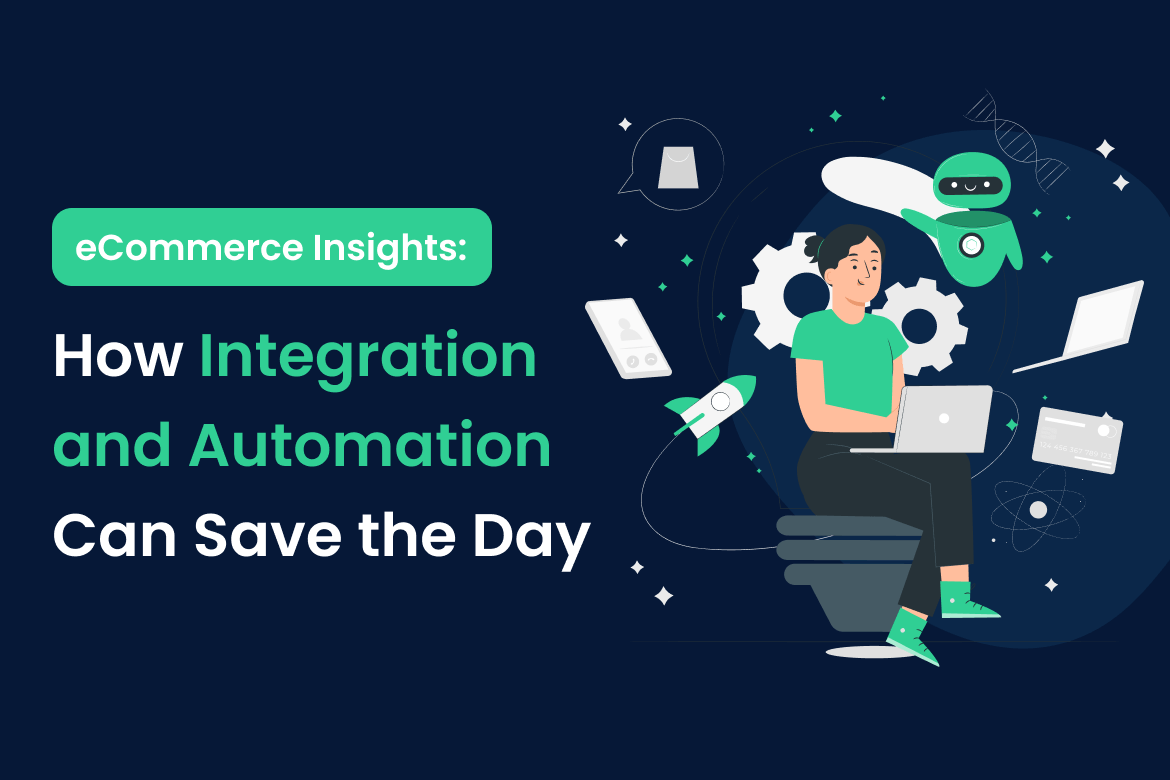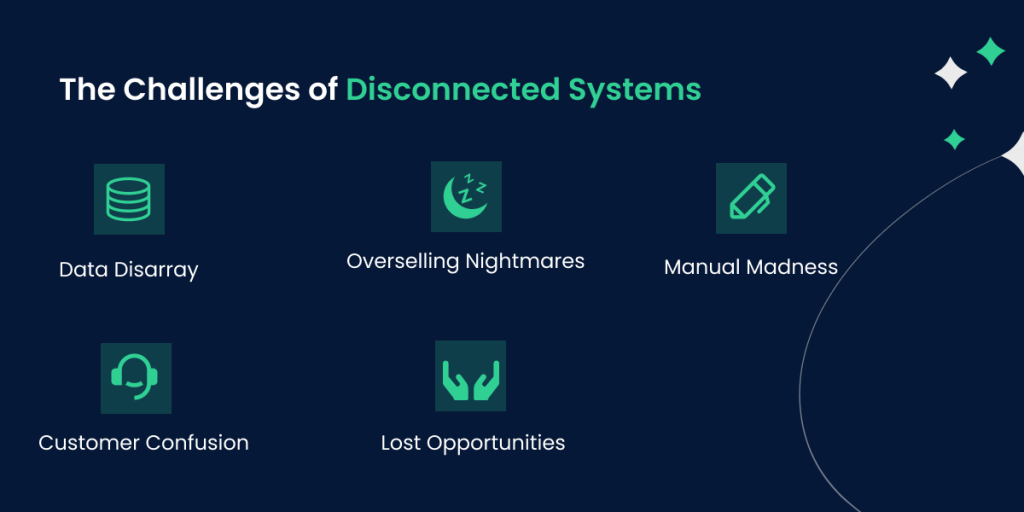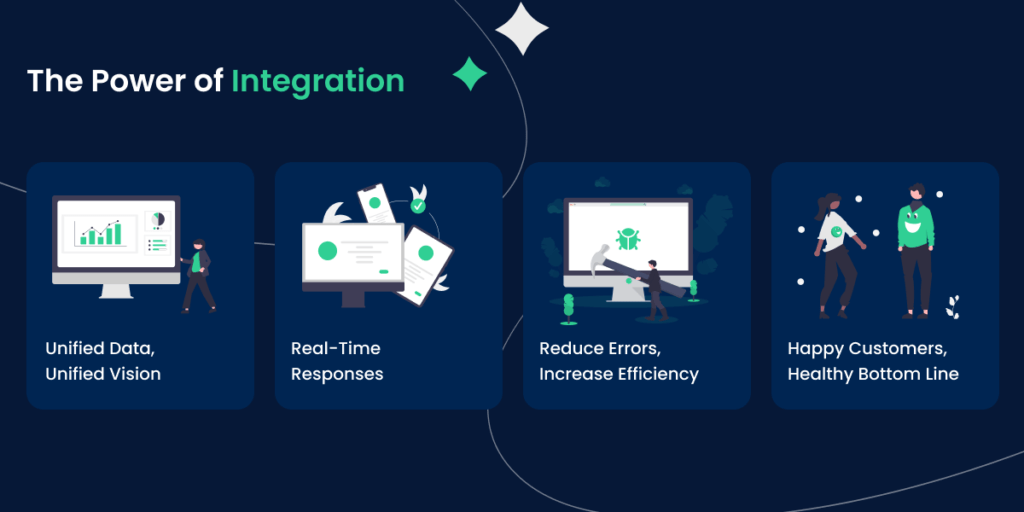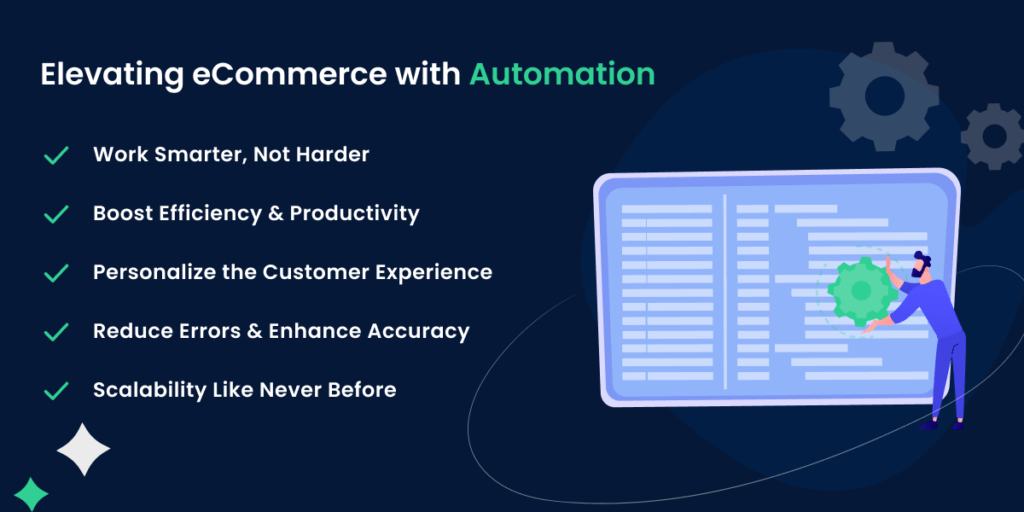eCommerce Insights: How Integration and Automation Can Save the Day
Written by
Editorial TeamPublished on

So, you’ve set your sights on making waves in the digital shopping arena. You’re bursting at the seams, eager to conquer the world of eCommerce. But just as you’re mapping out your online empire, you’re hit with a barrage of terms – “integration and automation” and a dozen others.
Suddenly, it feels like you’re wading through a thick fog, doesn’t it?
Enter the era of smart eCommerce – where it’s not just about dazzling product images and slick checkouts. Oh no, it’s a world where your systems gotta have that ‘talk-the-talk’ and ‘walk-the-walk’ synergy. Confused? Fear not.
We’ve rolled up our sleeves, dived into the techno jungle, and guess what? We’ve gained some precious insights about how integration and automation aren’t just buzzwords – they’re your eCommerce lifeline.
So, ready to discover how integration and automation can be the cape-wearing heroes of your eCommerce story? Strap in because we’re about to embark on quite the ride. And hey, you might just find a nifty tool waving at you from the horizon. Let’s dive in!
The Changing Landscape of eCommerce – The Only Constant is Change
Remember the days when eCommerce was just a virtual version of your local store? A basic list of products, a simple checkout, and a few grainy images to go by if you were lucky. Ah, the good ol’ days. But blink, and you’ll miss the next wave of change. Seriously, if eCommerce were a movie, it’d be on its fifth sequel by now, and guess what? The plot keeps thickening.
Today, eCommerce is no longer just about selling; it’s about creating immersive experiences. From 3D product views, AR try-ons, and chatbots that know just a tad bit too much about your preferences (it’s like they read your diary, right?), the digital shopping realm is evolving at warp speed.
And with the rise of social commerce, pop-up online boutiques, and even virtual reality stores (yes, that’s a thing!), the lines are blurring between what’s physical and what’s digital. Shopping online isn’t just about convenience anymore; it’s about experiencing something novel, unique, and sometimes downright futuristic.
But hold up! With great innovation comes great…complexity. The tools and tech stack required to keep up with these changes are mind-boggling. And if you’re not on top of your game, it’s easy to get lost in the labyrinth of options, platforms, and systems.
So, as the ancient Greek philosopher Heraclitus famously said, “Change is the only constant in life.” But in the whirlwind world of eCommerce, it’s not just about recognizing change; it’s about riding its wave and harnessing its power for success.
Are you game? Then keep reading because things are about to get even more interesting.
The Challenges of Disconnected Systems
Do you know that feeling when you’re trying to piece together a jigsaw puzzle and are convinced that a sneaky gremlin stole a piece in the night? That’s what running an e-commerce store with disconnected systems feels like. You’ve got all these shiny tools, but when they don’t click together, you’re left with gaps, confusion, and one colossal headache.

Let’s break it down.
1. Data Disarray: Imagine your CRM thinks Mr. Smith is a brand-new customer, but your email marketing tool sends him discounts on ‘loyal customers’. Oops! That’s not just embarrassing; it’s money down the drain.
2. Overselling Nightmares: There’s nothing worse than the dreaded “Out of Stock” message after you’ve already promised a customer their desired item. When your inventory management system isn’t synced with your online storefront, chaos isn’t just a possibility; it’s a guarantee.
3. Manual Madness: Spending endless hours manually updating products, prices, or customer details? That’s not just tedious; it’s time you could be using to strategize, innovate, or maybe even catch a quick nap!
4. Lost Opportunities: Your marketing platform crafted the perfect upsell campaign. But if it doesn’t know what your sales platform is doing, you might as well be shooting marketing arrows in the dark, hoping one hits a target.
5. Customer Confusion: Nothing irks a customer more than receiving conflicting information. One system says their order is shipped, another says it’s processing – and all they want to know is when their shiny new gadget will arrive!
See the pattern? Disconnected systems are like an orchestra where each musician is playing a different song. Sure, individually, they might sound great, but together? It’s just noise. And in the e-commerce world, noise translates to lost sales, miffed customers, and endless firefighting.
But what if we told you there’s a way to get all these tools singing in harmony? Intrigued? Hold onto your hats because we’re about to delve into the world of integration, and trust me, it’s a game-changer.
The Power of Integration
Alright, pop quiz! Remember those old superhero movies where a group of individuals, each with their own unique powers, come together to form an unbeatable team? Think of integration in the same way. Each of your eCommerce tools, with its own superpower, uniting to form… (cue the epic music)… The Ultimate eCommerce Machine!

Now, let’s unmask the magic of integration:
1. Unified Data, Unified Vision: With integration, data flows seamlessly across platforms. That means everyone – from sales to marketing to customer support – is singing from the same hymn sheet. No more “Oops, my bad!” moments; just a streamlined, cohesive strategy.
2. Real-Time Responses: Imagine updating stock levels instantly across all channels the moment a product flies off your digital shelf. Or having your marketing tools adjust campaigns on-the-fly based on live sales data. That’s the power of real-time integration.
3. Reduce Errors, Increase Efficiency: Manual data entry is not just tedious; it’s prone to errors (trust us, we’ve all been there!). Integration automates these processes, reducing mistakes and giving you back those precious hours.
4. Happy Customers, Healthy Bottom Line: When systems talk to each other, your customers benefit. They get accurate information, personalized experiences, and speedy service. And a happy customer? That’s your ticket to repeat business and glowing reviews.
Now, we know what you’re thinking. “This sounds epic, but isn’t it complicated?” Well, yes and no. The concept? It’s straightforward. The implementation? It can be tricky if you’re doing it alone. But here’s the good news: there are tools out there designed to make this process as smooth as silk.
With the right integration platform in your corner, you’re not just responding to the changing landscape of eCommerce; you’re shaping it. Ready to harness the true power of integration? Let’s keep this journey going.
Elevating eCommerce with Automation
Imagine, if you will, a world where your eCommerce operations run like a well-oiled machine, where tasks that once took hours magically complete themselves in minutes, and where once error-prone processes now flawlessly execute without you lifting a finger. Sounds dreamy, right? Well, welcome to the world of automation!

1. Work Smarter, Not Harder: Automation is the unsung hero that takes on repetitive tasks, freeing you up to focus on what truly matters. Whether it’s scheduling marketing campaigns, processing orders, or managing inventory – automation ensures it’s all done with clockwork precision.
2. Boost Efficiency & Productivity: Gone are the days of juggling multiple tasks and getting overwhelmed. With automation, processes are streamlined, ensuring maximum efficiency. It’s like having a virtual army working 24/7, ensuring your eCommerce operations never skip a beat.
3. Personalize the Customer Experience: Remember the joy of walking into your favorite local store and the owner recommending products based on what you bought last time? Automation can recreate that experience online. From personalized product recommendations to tailored email campaigns, automation ensures customers feel seen and valued.
4. Reduce Errors & Enhance Accuracy: Human errors are natural, but in the eCommerce world, they can be costly. Automation minimizes these risks. No more miscalculations, missed orders, or mismatched inventories. Just seamless operations day in and day out.
5. Scalability Like Never Before: As your business grows, so do the challenges. Automation ensures you’re always ready. Whether you’re managing 100 orders or 10,000, automated systems scale with your needs, ensuring you’re always delivering top-notch service.
But here’s the kicker: while automation is powerful, it’s most effective when built on a foundation of seamless integration. An automated system that isn’t well-integrated is like a Ferrari with bicycle wheels. It looks impressive, but it won’t get you far.
That’s why integration and automation platforms are a match made in heaven for eCommerce businesses. By combining the forces of integration and automation, they offer a holistic solution that supercharges your operations.
Yet, amidst marketing strategies and operational automation, a critical thought to ponder is how easing burdens on operational fronts allows for greater focus on growth aspects, particularly in fundraising and building relationships. For instance, streamlining the eCommerce model through an efficient fundraising CRM could significantly bolster donor engagement and fundraising efforts by automating integral communication tasks and data analysis.
So, as we venture deeper into this digital age, automation isn’t just a “nice-to-have”; it’s a “must-have.” Ready to elevate your eCommerce game? Automation is the rocket fuel you’ve been searching for.
Automation Through the Lens of Statistics
Hold onto your e-cart, because Europe’s on the brink of a digital transformation that could change the eCommerce game!
Ever wondered about Europe’s digital potential? Think big. The European market is bubbling with possibilities and has all the ingredients to become a digital giant. This isn’t just about buying online; it’s about the crisscrossing digital flows that Europe, paired with the US, is pioneering.
But, like every great story, there’s a plot twist: only a mere 15% of EU consumers are shopping online from another EU country. Compare that to the nearly 50% happily shopping within their borders. Oh, the missed opportunities!
But here’s the silver lining. Imagine a Europe with a fully realized Digital Single Market. We’re talking about the potential to double cross-border digital trade. And it’s not just about buying and selling; it’s the surge in digital services like web and video applications. Companies could unleash the true potential of a market without borders.
So, what’s the reward at the end of this digital rainbow? An eye-popping extra €2.5 trillion of GDP by 2025. Yes, you read that right. That’s a 10% leap above what the fortune tellers, I mean analysts, have projected. And the real magic? This number might just be the tip of the digital iceberg as the frontiers of digital expand.
But wait, there’s more. The European business realm isn’t just watching from the sidelines. They’re betting big on this digital rodeo. A recent treasure trove of data from the McKinsey Global Institute revealed that 55% of German moguls are raising their glasses to increase digitization and automation. Only a tiny 12% are pulling out their umbrellas, expecting rain. The Industry 4.0 revolution, powered by data, has them all buzzed. Germany’s already had a taste of this cocktail in the 90s. After splurging on manufacturing automation and bolstering their electronics sector, they saw both productivity and employment shoot up.
Europe’s got the digital map, the ship, and the crew. All it needs now is to set sail to unlock the treasures of the Digital Age for e-commerce!
Tackling e-Commerce: Integration, Automation, & Europe’s Digital Potential
Embarking on an e-commerce journey? Don’t get bogged down by techie terms. In the rapidly evolving e-commerce landscape, it’s more than just selling. Now, it’s about creating rich, immersive digital experiences. But, with innovation comes complexity. The myriad of tools can get confusing. Solution? Integration and automation.
Disconnected Systems? Big No-No!
Running an e-commerce store with disconnected systems feels like doing a jigsaw puzzle with missing pieces. Misaligned data, inconsistent stock levels, manual updates, mismatched marketing, and customer confusion? No thanks.
Integration to the Rescue
Think of integration as a superhero team-up. Individual e-commerce tools, each powerful on their own, come together to form an unstoppable force. Unified data, real-time updates, reduced errors, and a consistent customer experience – that’s the magic of integration. There’s a tool for that: SyncSpider. It’s the maestro that makes your e-commerce orchestra harmonize.
Automation: e-Commerce’s Best Friend
Visualize a self-driving e-commerce world. Automation streamlines operations minimizes errors, offers scalability, and personalizes customer experiences. But a pro tip? Integrate before you automate. Only then can you harness its full potential. And platforms like SyncSpider, combining integration and automation, are the game-changers.
Europe’s Digital Leap
Now, a surprising stat – only 15% of EU folks shop online from other EU nations, compared to 50% who shop domestically. A unified Digital Single Market in Europe could be a goldmine. By 2025, it could add an extra €2.5 trillion to the GDP. Moreover, businesses aren’t idle. A chunk of German bigwigs are leaning into digitization and automation. Europe’s poised for a digital renaissance in e-commerce.
About the Author

Aleksandar Stanisic
Chief Operation Officer at SyncSpider
Aleksandar shares his knowledge gained through more than 15 years of working experience in C-level executive positions.
***


